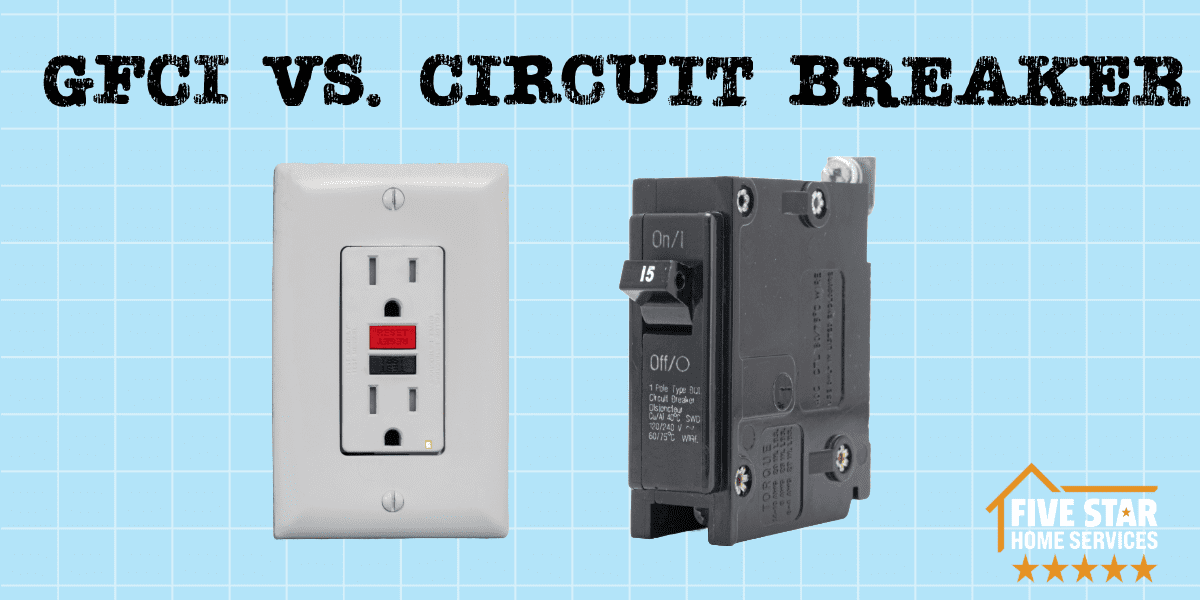We hardly give any thought to the standard, everyday items we have around the home, and yet the circuit breakers and GFCI breakers have tremendously important functions that protect our homes from electrical hazards. These two electrical fixtures provide the necessary protection in our ever-modern household that relies heavily on electricity.
What Is a Circuit Breaker?
It is a switching device designed to protect the electrical system from overloads, short circuits, abnormal currents, and surges, which can become fire hazards. It acts by “tripping” or turning off the electrical supply when a faulty current occurs, thus acting like a switch. These standard circuit breakers are located in your home’s main electrical panel.
Overloading of a current occurs when multiple connections handling several loads are present with just a single circuit breaker.
Short circuits happen when an electrical flow strays away from its intended path due to wires becoming exposed or not insulated and they come in contact. The immediate result is an increased amount of electricity in that path, causing arcing or sparks, a fire hazard.
What a Circuit Breaker Looks Like:
It has either a single- or double-pole switch that protects 15 to 20-amp circuits (single-pole) or larger circuits (double-pole) and are marked with “on” or “off.” Single-pole and double-pole breakers take up one slot and two slots in the electrical panel, respectively. When a breaker trips, you will find the switch moved to the “off” position, or somewhere in the middle between “off” and “on.”
What is a GFCI?
GFCI stands for “ground fault circuit interrupter,” and as such, is a device that detects ground faults in an electric current, to prevent them from going through your body and causing electrical shock or electrocution. It acts quickly to disrupt electrical power in the event of a faulty current, or when you happen to touch a faulty electronic device. GFCIs are especially important in protecting appliances and other electronics that are located in wet areas of the home, such as bathrooms, pools, basements, or garages. They are usually installed in wall outlets as receptacles but may be installed in the electrical panel.
Ground fault is an electrical current that accidentally steers itself away from an intended path or an established circuit and flows directly to the earth (or ground). When a person happens to be in the current’s path of least resistance, that person may be in danger of electrical shock.
What a GFCI looks like:
A GFCI receptacle looks like a standard wall outlet with a couple of buttons that are marked “test” and “reset.” Some of them are colored: red (reset) and black (test). Other receptacles are plain-colored, but the buttons are marked, nonetheless. When a GFCI detects a difference in the circuit by as little as 6 amps, it shuts off electricity to the outlet, and the “reset” button needs to be pushed back for it to work again to reset the power supply. The “test” button is used to check for the functionality of the GFCI by connecting the live wire with the ground wire in the outlet or whether it will trip when there is a ground fault.
Here are the main differences between a standard circuit breaker and a GFCI:
| STANDARD CIRCUIT BREAKER | GFCI | |
| Sensitivity | Less sensitivity; detects current flow in hot wire only | Increased sensitivity; breaks (trips) when current flow difference is >5 mAmp, detected in both hot and neutral wires |
| Location | In main electrical panel; in accessible areas but not in bathrooms and closets | In outlets such as GFCI receptacles, they are required in wet areas (e.g., bathroom, basement, garage, outdoors, near pool, etc.) |
| Appearance | May be a single-pole or double-pole switch with “on” and “off” positions | Like standard wall outlets but with test (black) and reset (red) buttons |
| Protection | Protects all outlets in the circuit from overloading, short circuits, sparks, and/or electrical fires | Protects from ground faults that cause electrical shocks in one outlet only (single location) or multiple outlets down the circuit (if wired as multiple-location). |
| Resetting | Switch to the “on” position at the main breaker (electrical) panel | Push “reset” button on the outlet itself |
| Installation | Done by a licensed electrician (recommended) | Can be installed by a competent DIY-er, although a licensed electrician is recommended |
Based on the differences between a standard circuit breaker and GFCI and what you need as a homeowner, you can depend on Five Star Home Services to make sure you have the correct electrical fixture installed for your home. Call Five Star Home Services now at (833) 405-8009 for any of our licensed electricians to help you stay safe in your home.


